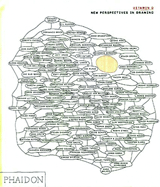By Mitch Epstein
Lorne Colon takes a look at the best art books of 2005
Phaidon; $70
A few years ago, super art-publisher Phaidon released a volume called “Vitamin P.” The book was an instant success, providing a broad survey of the current state of contemporary painting around the world. Phaidon has now released a sequel that focuses on drawing, appropriately titled “Vitamin D.”
So many survey books are published annually that it becomes difficult find a decent one. However, “Vitamin D” is the most thorough and beautifully produced book on contemporary drawing, or art in general, in recent memory. The book’s subject is matched perfectly by its format and design: large, beautifully reproduced images in full color on thick cream paper with deckled edges for each of the 110 artists chosen for the book. The pages feel like actual works of art laid into the book’s spine.
Instead of getting a “greatest hits” package of the same old names, “Vitamin D” serves up primarily fresh work from emerging artists. Most have seen little if any space in books before, while still allowing a handful of established names, making “Vitamin D” an exciting journey from cover to cover.
Monacelli Press; $65
Kiki Smith, a New York artist who emerged in the 1980s as an artist to watch, is being honored this season with a slew of traveling exhibitions and books covering her career to date. This book, published by Monacelli Press, is one of two in-depth monographs on the artist relating to a major retrospective on Smith’s work in the United States.
Kiki Smith, daughter of sculptor Tony Smith, has succeeded in developing her own language in sculpture, installation, prints, and numerous other media for the past two decades. This lush book provides almost 200 full-color reproductions of all of Smith’s major works, including her eerie, figurative sculptures and her carefully produced objects. The photos succeed in capturing their three dimensional feel — not an easy feat in a book— and brings Smith’s universe right to you.
Edited by Jeffrey Deitch & Kathy Grayson
Deitch Projects; $30
Deitch Projects is one of the few holdouts among the mass exodus of Soho galleries to Chelsea. Their two spaces have been an important outlet for countless emerging artists, and “Live Through This,” edited by Jeffrey Deitch and Kathy Grayson, is a photo album/diary of all things Deitch.
The book is one of a long line of releases that resemble a ‘zine or scrapbook, pulling together hundreds of photos of New York artists at their most decadent moments. If you want a decent look at the art that has been paraded through the Deitch galleries, you’ll be frustrated by page after page of twentysomethings partying in the name of fine art. Deitch has a good eye (and ear), and has put on some truly amazing shows and events, but this book isn’t a good place to see them. Rather, it focuses on the clichéd lifestyles in Deitch’s scene, documenting all the filth and fun.
Though a potentially great gift for an MTV obsessed teenager, as an art monograph “Live Through This” ultimately fails. Hopefully Deitch & Company will put out a stuffy companion so we can enjoy more of the artwork.
Merrell; $60
Several years after Francis Bacon’s death in 1992, the executor of his estate, John Edwards, donated the contents of the English painter’s studio to the Hugh Lane Gallery in Dublin, the artist’s birthplace. Inside Bacon’s legendary studio were a maelstrom of photos, paint supplies, liquor bottles, destroyed and half-finished paintings, and other detritus from his life’s work. The Hugh Lane, utilizing a massive team of experts and archeologists, cataloged and moved the studio piece by piece, down to every paint tube cap, from London to Dublin and reconstructed the space for public view.
This book is an impressive documentation of both the move and the contents of the studio itself. Cappock pulls back the curtain on Bacon’s work, showing us hundreds of photographic sources, dozens of drawings (Bacons always said he never drew), several unfinished works including his last, and views of the studio in all its glory.
Cappock connects the various items from the studio to Bacon’s paintings, and the reproductions include rarely seen work from his entire career. We see Bacon’s obsession with his lover George Dyer, and the reliance he had on photos before, during, and after a painting’s completion. This book is a must have for fans of Bacon’s work, as well as a unique look into the artist’s private laboratory.
Recreation: American Photographs, 1973-1988
Steidl Publishing; $75
Recently, photography monographs have become one of the biggest branches of the publishing universe. The books are usually lushly produced, as their subject matter requires only best reproduction values. New York-based photographer Mitch Epstein’s “Recreation,” which actually came out in the early part of this year, is one of those rare books that captures a time and feeling that no longer exists outside of these beautiful images he took during the 1970s and 80s.
Epstein, much like his contemporary William Eggleston, has built a career on taking pictures of the more mundane sides of American’s lives. Epstein’s unique power, however, lies in his ability to capture his subjects candidly, rather than photograph a set-up scene. Whereas objects in Eggleston’s work often share the spotlight, Epstein allows the people in his photos, which he took during his cross-country travels, to shine. They may be “normal” Americans, yet these large and colorful reproductions make the images, and those within them, seem extraordinary.
google_ad_client = “pub-6226499064891091”;
google_ad_width = 468;
google_ad_height = 60;
google_ad_format = “468x60_as”;
google_ad_channel =”0606561524″;
google_color_border = “336699”;
google_color_bg = “FFFFFF”;
google_color_link = “0000FF”;
google_color_url = “008000”;
google_color_text = “000000”;
//–>
src=”https://pagead2.googlesyndication.com/pagead/show_ads.js”>
WWW Downtown Express

























